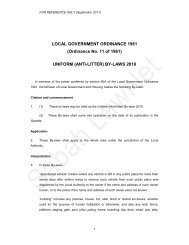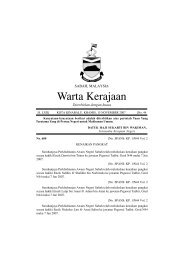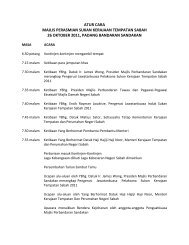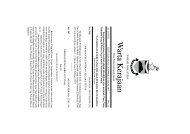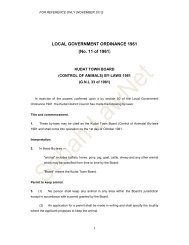hazard identification, risk assessment & risk control - Sabah
hazard identification, risk assessment & risk control - Sabah
hazard identification, risk assessment & risk control - Sabah
- No tags were found...
Create successful ePaper yourself
Turn your PDF publications into a flip-book with our unique Google optimized e-Paper software.
HAZARD IDENTIFICATION,RISK ASSESSMENT & RISKCONTROL(HIRARC)Assoc. Prof. Dr. Shamsul Bahari ShamsudinSchool of MedicineUNIVERSITI MALAYSIA SABAH
OBJECTIVES• To identify types of Hazard in work area• To make Risk Assessments• To suggest Risk Controls to Organization• To implementing Risk Controls• To review Risk Controls
HIRARC -Planning & ImplementationLEGALACCIDENT &NEAR MISSESFEEDBACK &COMPLAININSPECTION& AUDITHIRARCSOPINTERNALAUDIT POLICY SAFETYCOMMITTEETRANINGERPMANAGEMENT PROGRAM
OSH-MS (MS 1722:2003)Key Elements• Policy• Organizing• Planning And Implementation• Measuring Performance• Action for Improvement
Why We Need OSH-MS• Our Organization to be ‘world classstandard’• Increase “Return of Investment”- employees, money , time…..• Safe work place
How To Start• Organization should have vision• Commitment from management- right people- resource- time
How To Start• Should have internal audit• Management committee to review reports• External audit• Specific organization policy- <strong>hazard</strong> specific• Employee’s participation - meeting, training• Safety as basic training
Introduction to HIRARC• Principles used in workplace to managesafety and health.• Section 15 (2)(a) of OSHA 1994:which reads “ the provision and maintenanceof plants and systems of work that are, so faras is practicable, safe and without <strong>risk</strong>s tohealth”
• HazardDefinitionA source or a situation with a potential for harmto humans, property and damage of environmentor a combination of these.• DangerRelative exposure to <strong>hazard</strong>.• RiskA combination of likelihood of occurrence andseverity of injury or damage.
Overview Of HIRARC• Definition of Hazards• Classification of Hazards• Potential sources of Hazards• Basic components of Risk Management
The Process of Risk ManagementClassify Activities(Work, Product, Services)Identify HazardAssess The RiskRisk ControlReview Risk Control
Classification & Potential Sources of HazardsClassification Example of HazardsMechanical - Sharp points & edges, overload.Electrical - Insulation damaged or cover brokenBiological - Exposed, airborne/blood bornemicroorganism.Chemical - Expose to carcinogens chemicalErgonomics - Expose to unnatural posturesPsychological- Stress or violent at workplace.
Hazard Identification• To keep workplace safe and healthy.employers should make sure there are no <strong>hazard</strong>sto which employees could be exposed.• Employers should look for <strong>hazard</strong>s in advanceas part of their <strong>risk</strong> management plan to preventpotential <strong>hazard</strong>s.
Actions & Recommendations• All related statements should be made• With no cost restrains• Should be reviewed every 4 months• Need management support
Risk AssessmentIs the process of evaluating the <strong>risk</strong> to safety &health from <strong>hazard</strong>s at workTypes- Qualitative- Semi-quantitative- Quantitative
How To Assess Risk1) Look for the Hazards2) Decide who might be harmed & how3) Evaluate the <strong>risk</strong> and check what isdone to prevent it from happening4) Record finding5) Review <strong>assessment</strong> and revise it ifnecessary
Types of Risk AssessmentQualitative - (Use Risk Matrix)-table scales for likelihood and severity• Fatality• Major injuries• Minor injuries• First aid or near misses
Types of Risk AssessmentBased on statisticLikelihood1 Very likely2 Likely3 Unlikely4 Highly Unlikely
Qualitative Risk TableSeverityLikelihoodV/Likely Likely Unlikely H/UnlikelyFatality High High High MediumMajorInjuriesMinorInjuriesFirst Aid/N/missesHigh High Medium MediumHigh Medium Medium LowMedium Medium Low Low
Semi-Quantitative Risk AssessmentSeverity Categories1. First Aid2. Less than 4 days M/C3. More than 4 days M/C4. Fatality & Permanent Disability
Semi-Quantitative Risk AssessmentLikelihood Occurrence1. Yearly2. Monthly3. Weekly4. Daily
Semi-Quantitative Risk TableLIKELIHOODSEVERITyYearly Monthly Weekly Daily1 2 3 4First Aid 1 1 2 3 4< 4 Days MC 2 2 4 6 8> 4 Days MC 3 3 6 9 12Fatality &PermanentDisability4 4 8 12 16
Quantitative Risk AssessmentIn cases where <strong>hazard</strong>s are numerous andcomplexeg; Chemical LaboratoryShould have Job Safety Analysis (JSA)- describe job in less than 10 steps- List things that can go wrong- eg; Mixed chemical during student experiment
Actions & Recommendations• EL- Eliminate• SL- Substitute• IS-• EC-• AC -• PPE-IsolationEngineering ControlAdministration ControlPersonal Protection Equipment
Actions & RecommendationsEg;EL - stop work, cover <strong>hazard</strong>…SL - use other route, other material..IS - put up temporary barrier,…EC - construct permanent wall,..AC - put up notice, job rotation,…PPE - gloves, respirator,……



